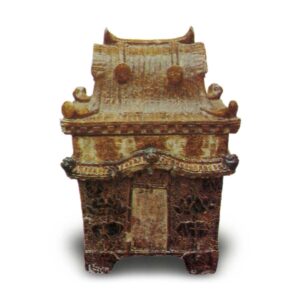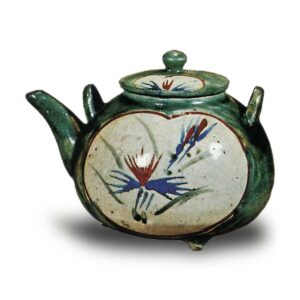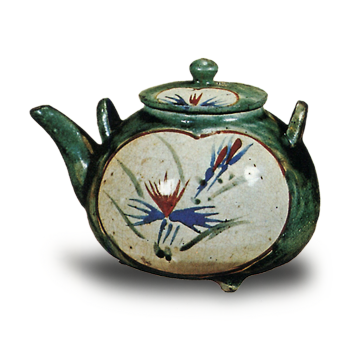

Ryukyu ware is a type of coarse pottery produced in Ryukyu (Okinawa Prefecture).
In 1617, when King Shonei sent an envoy to Kagoshima, Satsuma Province, he invited three naturalized Korean potters, Ichikan and Sangan, to return to Ryukyu and teach their skills to the islanders. Ichikan and Sangan were quickly recalled to the Shimazu clan, and Ichiroku alone remained. Ichiroku later changed his name to Nakachi Reishin and taught the Ryukyuans the art of pottery making, and his descendants also inherited his legacy. This was the beginning of pottery making in Ryukyu. At the end of the Genroku period (1688-1704), a man named Nakamurakuchi Chigen appeared in Naha Izumisaki and became a potter, and in 1723 (Kyoho 8), he improved the traditional production method and greatly developed the pottery industry. In 1730, he went to Kagoshima Tateno Kiln to learn pottery techniques from Hoshiyama Nakatsuji Hayashi Shin’emon, and also learned various techniques at Nayogawa Kiln, and the following year, he followed the Satsuma Kiln and built a new kiln at Kohakura Yamanouchi. The following year, he built a new kiln in Kohazura Yamanouchi and further improved it, producing a large flower pot for contribution to Japan in 1733. Local potters did not know how to make them at first, but they were able to produce them under Chigen’s instruction. Chigen was the founder of the Ryukyuan pottery industry, and his grandson, Nakamurakuchi, was granted a new family title in 1752, and was given a special order to produce Ryukyu-Soak color-painted sake cups. In 1748, a potter named Shimabukuro Tsuneo from Izumisaki, Naha, started his own business. Using clay from the Onna and Nago Makiri areas, he produced dark green or blackish-brown ware that was slightly soft, and white-glazed ware with a slight yellow tinge. In 1838, Nakamurakado Chishin, a descendant of Chigen, traveled to Fuzhou, China, at his own expense, to learn the painting method from Zhao Shichang, a native of Xiamen, for seven months, and returned to greatly improve his pottery production. Later, in March 1879, when the Ryukyu domain was abolished and Okinawa Prefecture was established, new methods were introduced from various parts of Japan, but the products still seem to have remained within the range of crude pottery and stoneware.
Amoi [products] are of two types. The first is rough stoneware and earthenware, both unglazed. The rare examples are almost glossless and have the appearance of being unglazed. This is what is known as Namban ware. The main type of jar is the awamori jar, but there are also urns and other types of pots, as well as water bowls, washpots, and flowerpots.
The pots include water bowls, wash bowls, and flowerpots, and the jars are made from pieces of height and diameter around 75 centimeters. The types include rice bowls, bamboo shoots, sencha bowls, sake cups, small plates, medium-sized plates, tea house (earthenware bottles), incense burners, Buddhist ritual utensils, jarware (urns), oil jars, fire bowls, a-bottles (water jars), tochu-ke (sake cups), yuchu-ke (sake bottle), ibin (fire sake bottle) and single-flowered flower vases, among others.



